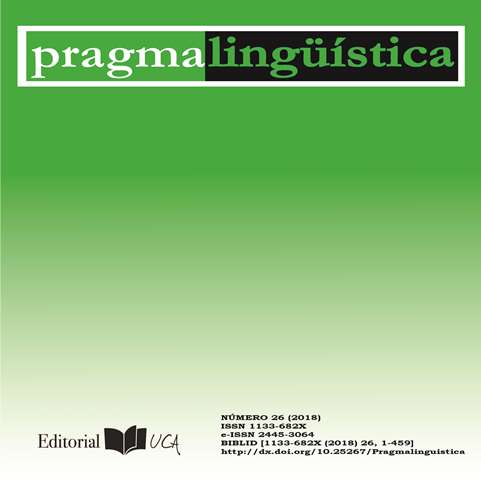Effect of explicit instruction on implicature's interprétation in English-speaking learners of Spanish as a second language

DOI
https://doi.org/10.25267/Pragmalinguistica.2018.i26.19%20Info
Abstract
This paper aims to determine first the effect of explicit instruction on the comprehension of implicatures in Spanish as a Second Language (SSL); second, whether there is a connection between learners’ grammatical accuracy and their ability to understand such implicatures; and third, if there is a type of implicature which proves more difficult/problematic to acquire. The sample was formed by 23 participants, learners of SSL. They were divided into 6 groups (3 experimental groups and 3 control groups) according to their competence level in Spanish. The 3 experimental groups participated in a 30- minute-long explicit instruction session about implicatures. Even though the statistics did not support the results, there was a slight improvement of the group with the highest competence level. This result is line with previous studies showing that highest level learners profit more from explicit instruction to interpret implicatures.
Keywords
Downloads
How to Cite
License
Copyright (c) 2018 Pragmalingüística

This work is licensed under a Creative Commons Attribution-NonCommercial-ShareAlike 4.0 International License.
References
BARDOVI-HARLIG, K. (1996) Pragmatics in Language Teaching: Bringing Pragmatics and Pedagogy Together. Pragmatic and Language Learning. Monograph Series. 7(1), pp. 21-39.
BOUTON, L. (1994) Can NNS Skill in Interpreting Implicature in American English Be Improved through Explicit Instruction? A Pilot Study. Pragmatic and Language Learning. Monograph Series. 5(1), pp. 89-109.
CIGNETTI, L. M., & DI GIUSEPPE, M. S. (2015). Pragmatic awareness of conversational implicatures and the usefulness of explicit instruction. Revista Nebrija de Lingüística Aplicada, 9(0). Publicación electrónica. Disponible en: https://www.nebrija.com/revista-linguistica/files/articulosPDF/articulo_56598f3498e3f.pdf (Fecha de consulta 3/9/17).
CLENNELL, C. (1999) Promoting Pragmatic Awareness and Spoken Discourse Skills with EAP Classes. ELT Journal, 53(2), pp. 83-91.
COX, J. (2015) Explicit Instruction, Bilingualism and the Older Adult Learner. Studies in Second Language Acquisition, 2015, pp. 1-30.
ESLAMI-RASEKH, Z. (2004) Raising the Pragmatic Awareness of Language Learners. ELT Journal, 59(3), pp. 199-208.
FORDYCE, K. (2013) The Differential Effects of Explicit and Implicit Instruction on EFL Learners’ Use of Epistemic Stance. Applied Linguistics, 35(1), pp. 6-28.
GAZDAR, G. (1979). Pragmatics:Implicature, Presupposition and Logical Form. New York: Academic Press.
GRICE, H. P. (1975). Logic and Conversation, en P. Cole y J. Morgan (eds.) Syntax and Semantics, 3: Speech Acts, New York: Academic Press, pp. 41 – 58.
GRICE, H. P. (1989) Studies in the Way of Words. (3a. Ed.). Cambridge, Estados Unidos: Harvard University Press.
HORN, L. (1984). Toward a New Taxonomy for Pragmatic Inference: Q-Based and R-Based Implicature, en D. Schiffin (ed.), Meaning, Form and Use in Context: Linguistic Applications, Washington: Georgetown University Press, pp. 11 – 42.
KASPER, G., ROSE, K. (2002) Pragmatics in Language Teaching. (1a. Ed.). Cambridge, Estados Unidos: Cambridge University Press.
KASPER, G., & SCHMIDT, R. (1996). Developmental Issues in Interlanguage Pragmatics. Studies in Second Language Acquisition, 18, pp. 149–169.
KUBOTA, M. (1995) Teachability of Conversational Implicature to Japanese EFL learners. IRLT (Institute for Research in Languaje Teaching) Bulletin, 9 (1), pp. 35-67.
LEECH, G. N. (1983). Principle of Prgamatics, Londres: Longman.
LEONETTI, M. (1993) Implicaturas generalizadas y relevancia. Revista Española de Lingüística, 23(1), pp. 107-139.
LEVINSON, S. (1983). Pragmatics. Cambridge: Cambridge University Press.
LEVINSON, S. (1987). Minimization and Conversational iterference, en Verschueren, J. Y Bertuccelli-Papi, M (eds.), The Pragmatic Perspective, Amsterdam: John Benjamins, pp. 61 – 129.
MARTÍNEZ-FLOR, A. Y ALCÓN, E. (2004) Developing Pragmatic Awareness of Suggestions in the EFL Classroom: A Focus on Instructional Effects. Canadian Journal of Applied Linguistics (CJAL), 10 (1), pp. 47 – 76.
MCMANUS, K. (2017) L1 Explicit Instruction Can Improve L2 Online and Offline Performance. Studies in Second Language Acquisition, 39 (3), pp. 459 - 492.
MEDGYES, P. (1992). Native or native: Who´s worth more? ELT Journal, 46 (4), pp. 340 – 349.
PEARSON, L. (2006) Patterns of Development in Spanish L2 Pragmatic Acquisition: An Analysis of Novice Learner’s Production of Directives. The Modern Language Journal, 90 (4), pp. 473-495.
REYES, G. (2003) El abecé de la pragmática. (6a. Ed.). Madrid, España.: Arco Libros, S.L.
RIDAO, S. (2008) Análisis pragmalingüístico de resoluciones de conflictos: las mediaciones laborales. Propuestas de investigación. (1a. Ed.) Almería, España: Universidad de Almería.
ROSE, K. (1994) Pragmatic Consciousness-Raising in an EFL context. Pragmatics and Language Learning. Monograph Series. 5 (1), pp. 52-63.
SCHMIDT, R. (1990). The Role of Consciusness in Second Language Learning, Applied Linguistics, 11 (2), pp. 129 – 158.
SCHMIDT, R. (1993a). Consciousness, learning, and interlanguage pragmatics, en G. Kasper & S. Blum-Kulka (Eds.), Interlanguage pragmatics, pp. 21–42. New York: Oxford University Press.
SCHMIDT, R. W. (1993b). Awareness in second language acquisition. Annual Review of Applied Linguistics, 13, pp. 206–226.
WIDDOWSON, H. (1992). ELT and EL teachers: Matters arising, ELT Journal, 46 (4), pp. 333 – 339.
WILSON, D. Y D. Sperber (1986). Interference and Implicature, en Travis, C. (ed,), Meaning and Interpretation, Oxford: Blackwell, pp. 45 – 75. Reimpreso en Davis, S. (ed.), 1991, Pragmatic: a Reader, Oxford: Oxford University Press, pp. 377 – 392.






